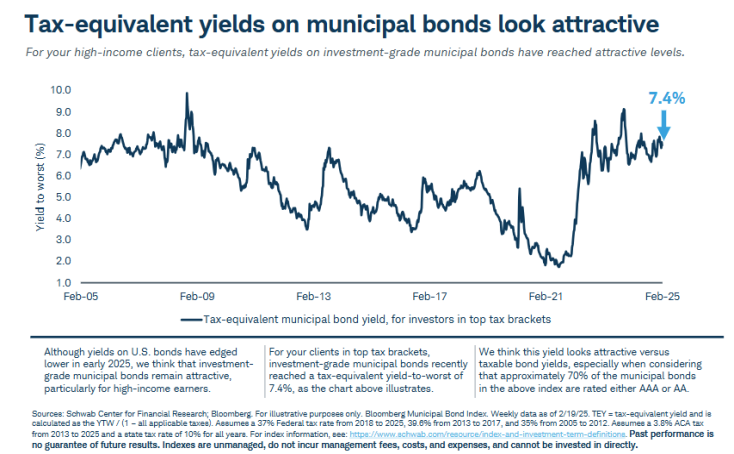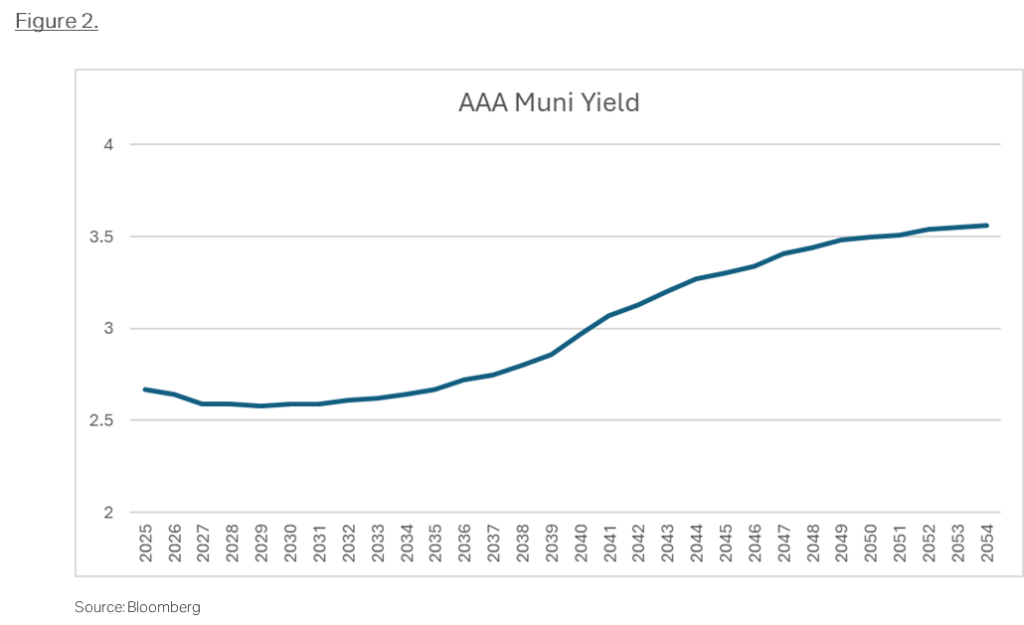- On Friday, July 4th, 2025 (Independence Day), President Trump signed the “One Big Beautiful Bill Act” (OBBBA) into law, a day after its passage by Congress.
- This massive piece of legislation, a cornerstone of the President and Republican Party’s agenda, extends expiring provisions of the Tax Cuts and Jobs Act (TCJA) of 2017 and incorporates other tax priorities of President Trump. It also outlines spending reductions and revenue-raisers to partly offset the estimated cost of the aforementioned tax provisions.
- OBBBA makes permanent several expiring tax cuts in the TCJA and potentially enhances some of those cuts. This is largely expected to benefit individual income taxpayers as the TCJA had made corporate tax breaks permanent.
- Crucial to the municipal bond industry, the bill left the highly coveted federal municipal bond tax-exemption intact. This followed months of intense lobbying and congressional outreach by industry groups/proponents highlighting the vital role municipal bonds play in financing core U.S. infrastructure. The potential threat of municipal bonds losing their tax exemption dominated sector headlines and caused consternation amongst investors over the past few months.
- CIM, unlike some of our peers, repeatedly reiterated its view that these fears were overstated and a broader loss of municipal tax-exemption was highly unlikely (see links to our previous commentaries here). With this legislation’s passage, we feel vindicated in the durability of our conviction as we seek to effectively and responsibly invest client assets through uncertain times.
Key OBBBA provisions specifically as they apply to CIM holdings are outlined below:
- Extension of Alternative Minimum Tax Exemption (AMT). The higher individual AMT exemption amounts and phase-out income thresholds (with tweaks to the income thresholds) have been permanently extended for tax years starting on January 1, 2026. The current AMT provisions were slated to expire at calendar year-end 2025 and would have reverted to pre-TCJA levels. This permanent extension should, in our view, bolster AMT bond valuations and liquidity.
- Private Activity Bonds. The legislation left private activity bonds intact and expanded their scope. Private activity bonds are extensively used to finance projects across municipal sectors such as airports, housing, toll roads, high-speed rail and other municipal project financings.
- Increased Endowment Tax Rates. Private higher education institutions will be subject to increased endowment tax rates based on their endowment levels per student and enrollment size. The new tax rates are progressive with higher rates most meaningfully impacting larger, wealthier institutions with sizeable endowments. Notably, the legislation’s endowment tax rates were materially scaled back from the more onerous House-passed version, somewhat blunting its negative effects on impacted institutions.
- Our higher education sector exposure is intentionally modest given underlying sector credit risks (weakened demographics, affordability challenges, to name a few) and relative value considerations. For our higher education holdings, we do not foresee material changes to credit profiles.
- Significant Medicaid Cuts. Key changes include imposing work requirements for recipients, more frequent redeterminations for enrollees, freezes and a lowering of provider taxes by states, reduction of supplemental payments, coupled with enhanced eligibility rules and checks. While this could prove disruptive to states and healthcare provider finances (particularly those serving larger Medicaid/self-pay populations), we expect them to take proactive steps to blunt the negative effects of some of these shocks. Moreover, some of these requirements and cuts will be staggered over time.
This material has been provided for informational purposes only and is not intended by Clinton Investment Management to provide and should not be relied on for tax, legal or accounting advice. If such advice is required, please consult with your own tax, legal and accounting advisors.
Please remember that past performance may not be indicative of future results. Net-of-fee performance returns are calculated by deducting the actual Clinton Investment Management, LLC investment management fee from the gross returns. Performance returns include the reinvestment of income and capital gains. Actual results may differ from the composite results depending upon the size of the account, investment objectives, guidelines and restrictions, inception of the account and other factors. Different types of investments involve varying degrees of risk, and there can be no assurance that the future performance of any specific investment, investment strategy, or product, made reference to directly or indirectly in this newsletter (article), will be profitable, equal any corresponding indicated historical performance level(s), or be suitable for your portfolio. Due to various factors, including changing market conditions, the content may no longer be reflective of current opinions or positions. Moreover, you should not assume that any discussion or information contained in this newsletter (article) serves as the receipt of, or as a substitute for, personalized investment advice from Clinton Investment Management, LLC. To the extent that a reader has any questions regarding the applicability of any specific issue discussed above to his/her individual situation, he/she is encouraged to consult with the professional advisor of his/her choosing. Please consult with an investment professional before making any investment using content or implied content from any investment manager. A copy of our current written disclosure statement discussing our advisory services and fees is available upon request.
The views and opinions expressed are not necessarily those of the distributing firm or any affiliates. Nothing discussed or suggested should be construed as permission to supersede or circumvent your firm’s policies, procedures, rules, and guidelines.











